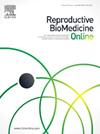人胚泡线粒体DNA定量分析及辅助生殖结果
IF 3.7
2区 医学
Q1 OBSTETRICS & GYNECOLOGY
引用次数: 0
摘要
研究问题:接受滋养外胚层活检的囊胚中人类滋养外胚层细胞线粒体DNA (mtDNA)的含量是否与胚胎变量和辅助生殖技术(ART)的结果相关?为了研究营养外胚层活检组织中mtDNA的含量是否与IVF结果相关,我们分析了2022年6月至2024年8月期间136个植入前基因检测(PGT)周期的462个囊胚活检组织。研究了用于单冷冻胚胎移植的人整倍体囊胚(n = 75)。采用全基因组扩增和下一代测序技术分析了滋养外胚层细胞的mtDNA水平。结果广义线性回归分析显示,只有胚胎整倍性与线粒体DNA拷贝数(MCN)显著相关(P <;0.0001)。HCG触发日黄体酮和LH浓度与MCN无相关性。同时,校正胚泡形态后,非整倍体的mtDNA含量高于整倍体。MCN与妊娠结局差异无统计学意义(P = 0.619),以中位数分为高、低组或四分位数分为四组,差异均无统计学意义。结论无论胚泡形态如何,整倍体胚的mtDNA拷贝数明显少于非整倍体胚。然而,妊娠结局没有统计学上的显著差异,这表明mtDNA拷贝数可能不是体外受精最佳临床成功和高能力潜力的良好预测指标。本文章由计算机程序翻译,如有差异,请以英文原文为准。
Analysis of mitochondrial DNA quantification in human blastocysts and assisted reproduction outcomes
Research question
Does the content of mitochondrial DNA (mtDNA) in human trophectoderm cells in blastocysts that received trophectoderm biopsy correlate with embryonic variables and the outcomes of assisted reproductive technology (ART)?
Design
To investigate whether the content of mtDNA in trophectoderm biopsies correlates with IVF outcome, 462 biopsies of blastocysts from 136 preimplantation genetic testing (PGT) cycles conducted between June 2022 and August 2024 were analysed. Euploid human blastocysts (n = 75) used in single frozen embryo transfer were studied. The mtDNA levels in trophectoderm cells were analysed by whole genome amplification and next-generation sequencing.
Results
Generalized linear regression analysis showed that only embryo euploidy was significantly associated with mitochondrial DNA copy number (MCN) (P < 0.0001). Progesterone and LH concentration on HCG trigger day were not associated with MCN. Meanwhile, aneuploids had more mtDNA quantities than the euploids after correcting for blastocyst morphology. No statistically significant differences were found in the MCN and pregnancy outcomes (P = 0.619), and there were also no statistically significant differences were found when divided into high and low groups based on the median value or four groups at the quartiles.
Conclusions
Regardless of blastocyst morphology, euploid embryos had significantly fewer mtDNA copy numbers than aneuploid embryos. Nevertheless, pregnancy outcomes showed no statistically significant variations, suggesting that mtDNA copy number may not be a good predictor of optimal clinical success and high competence potential in IVF.
求助全文
通过发布文献求助,成功后即可免费获取论文全文。
去求助
来源期刊

Reproductive biomedicine online
医学-妇产科学
CiteScore
7.20
自引率
7.50%
发文量
391
审稿时长
50 days
期刊介绍:
Reproductive BioMedicine Online covers the formation, growth and differentiation of the human embryo. It is intended to bring to public attention new research on biological and clinical research on human reproduction and the human embryo including relevant studies on animals. It is published by a group of scientists and clinicians working in these fields of study. Its audience comprises researchers, clinicians, practitioners, academics and patients.
Context:
The period of human embryonic growth covered is between the formation of the primordial germ cells in the fetus until mid-pregnancy. High quality research on lower animals is included if it helps to clarify the human situation. Studies progressing to birth and later are published if they have a direct bearing on events in the earlier stages of pregnancy.
 求助内容:
求助内容: 应助结果提醒方式:
应助结果提醒方式:


